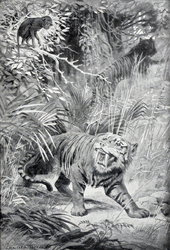Machairodus
| Machairodus Temporal range: Late Miocene | |
|---|---|
| | |
| M. aphanistus skull | |
| Scientific classification | |
| Kingdom: | Animalia |
| Phylum: | Chordata |
| Class: | Mammalia |
| Order: | Carnivora |
| Family: | Felidae |
| Tribe: | †Machairodontini |
| Genus: | †Machairodus Kaup, 1833 |
| Type species | |
| †Machairodus aphanistus Kaup, 1832 | |
| Species | |
| |
Machairodus was a genus of large machairodontine saber-toothed cats that lived in Europe, Asia, Africa and North America during the late Miocene.
Description

"Nimravides" catacopis stood about 1 m at the shoulder. Machairodus coloradensis was apparently significantly larger, about 1.2 m at the shoulder, according to skeletal and life reconstructions.[1] If accurate, this would make M. coloradensis one of the largest felids.
The skull of Machairodus was noticeably narrow compared with the skulls of modern pantherine big cats, and the orbits were relatively small. The canines were long, thin and flattened from side to side but broad from front to back like the blade of a knife, as in Homotherium. The front and back edges of the canines were serrated when they first grew, but these serrations were worn down in the first few years of the animal's life.
Machairodus was about 2 metres long and probably hunted as an ambush predator. Its legs were too short to sustain a long chase, so it most likely was a good jumper, and used its canines to cut open the throat of its prey. Its teeth were rooted to its mouth and were not too delicate, unlike most saber-toothed cats of the time, which had extremely long canines which hung out of their mouths. The fangs of Machairodus, however, were able to more easily fit in its mouth comfortably while being long and effective for hunting.[2]
Classification
The fossil species assigned to the genus Machairodus were divided by Turner into two grades of evolutionary development - M. aphanistus and the North American "Nimravides" catacopis representing the more primitive grade, and M. coloradensis and M. giganteus representing the more derived grade.[1] The characteristics of the more advanced grade include a relative elongation of the forearm and a shortening of the lumbar region of the spine to resemble that in living pantherine cats.[1] These trends would be taken further in Homotherium, which is thought to have evolved from Machairodus.
References
- ↑ 1.0 1.1 1.2 Turner, Alan; Antón, Mauricio (1997-04-15). The Big Cats and Their Fossil Relatives. Columbia University Press. p. 233. ISBN 978-0-231-10228-5. OCLC 34283113.
- ↑ Legendre, S.; Roth, C. (1988). "Correlation of carnassial tooth size and body weight in recent carnivores (Mammalia)". Historical Biology 1 (1): 85–98. doi:10.1080/08912968809386468. Retrieved 2011-06-03.